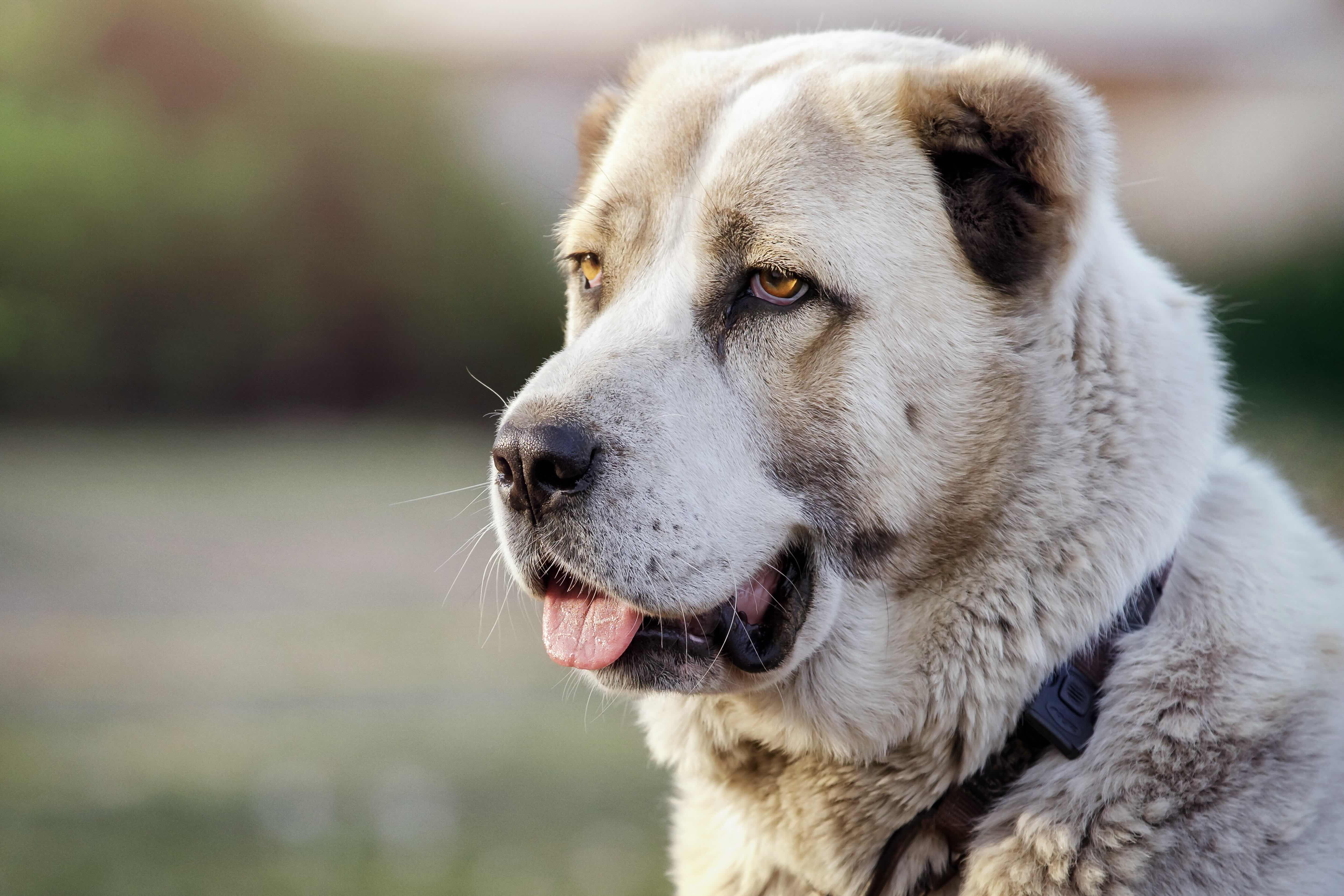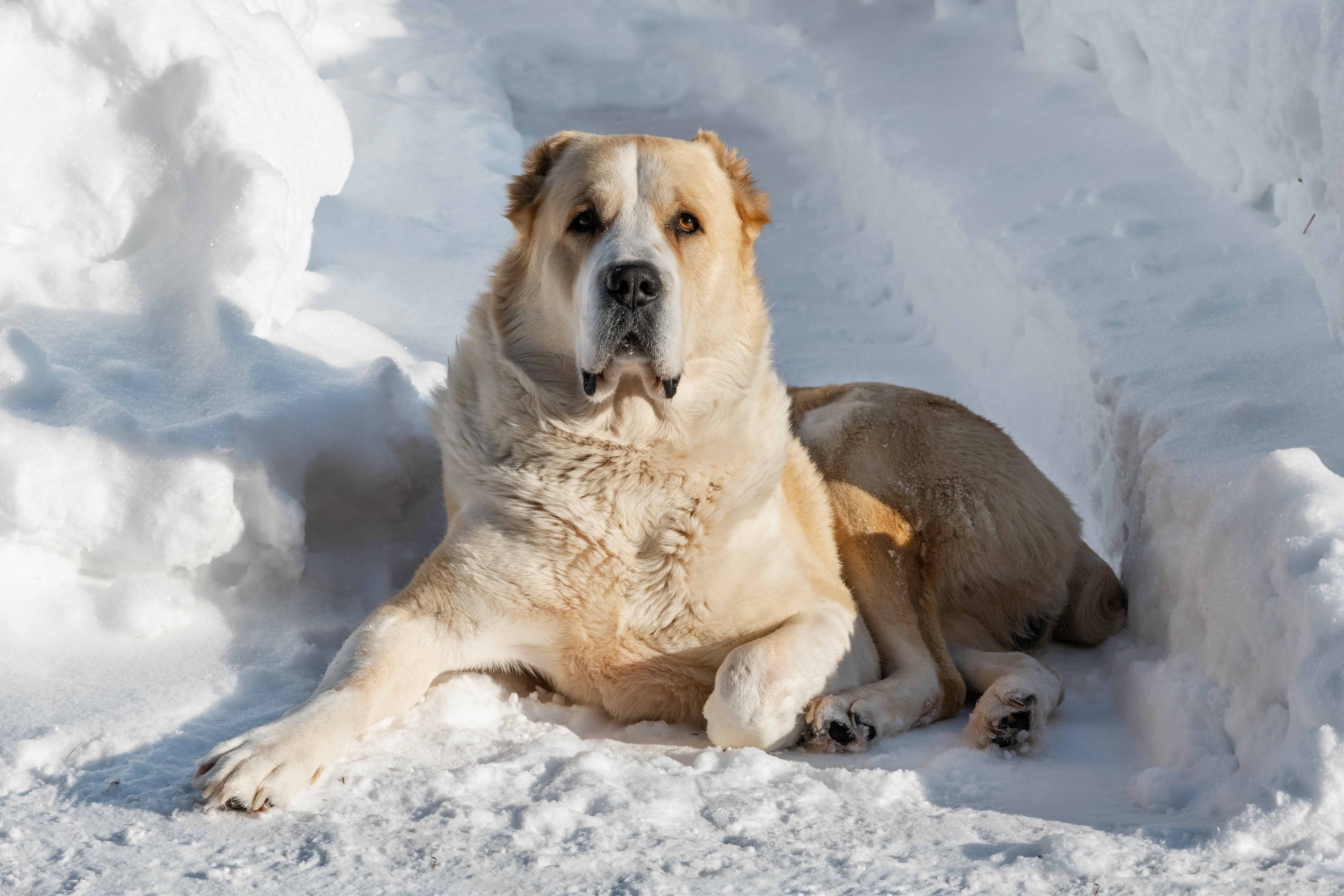Central Asian Shepherd Dog
Adobe Stock/Linas T
The Central Asian Shepherd Dog is a loyal, loving, courageous dog that might be more comfortable overseeing livestock than living as a family pet.
Originating from a vast territory including present-day Turkmenistan, Afghanistan, and Iraq, Central Asian Shepherd Dogs developed by natural selection over thousands of years.
Tasked with protecting people and their possessions (including livestock), these dogs had to persevere against rugged terrain, harsh weather, and predators, including bears and lions. The breed standard describes the Central Asian Shepherd Dog temperament as strong, fearless, and independent, with a high capacity for work and endurance.
Central Asian Shepherd Dogs weigh 88–110 pounds or more and stand 22.5–27.5 inches or taller. According to the breed standard, they have a robust, muscular body; a massive, rectangular head; thick, loose skin; and a coarse double coat.
You’ll often see Central Asian Shepherd Dogs with a docked tail and cropped ears, though these practices are controversial and opposed by the American Veterinary Medical Association and the American Animal Hospital Association.
Caring for a Central Asian Shepherd Dog

Central Asian Shepherd Dogs might not be a good dog breed for first-time pet parents. They need someone with the experience and skills to provide a large, independent dog with lifelong training and oversight. The ideal home for a Central Asian Shepherd Dog would also include some room to run and a sturdy fence.
Central Asian Shepherd Dog puppies must begin socialization as soon as you bring them home, as this breed can be more reserved around new people due to their centuries of working as guardians. The breed can do well with other dogs and smaller animals like cats, as long as they’ve had supervised introductions when your Central Asian Shepherd Dog puppy is young.
This breed has a medium amount of energy and benefits from daily exercise. Leashed walks and romps in the yard can fulfill this need. Not clingy, but also not aloof, Central Asian Shepherd Dogs are happiest when they’re at their pet parent’s side.
Central Asian Shepherd Dog Health Issues

The typical Central Asian Shepherd Dog lifespan is 10–15 years.
They are generally healthy dogs thanks to their natural development. But like all breeds, they’re not free of health problems, and it’s recommended that breeders screen Central Asian Shepherd Dog puppies for hip dysplasia.
Hip Dysplasia
Hip dysplasia is a genetic condition in which the hip joint doesn’t develop properly. This causes the joint to be loose, which eventually leads to degenerative joint disease (osteoarthritis).
Mild cases are treated with interventions like weight loss, physical therapy, and anti-inflammatory drugs, but severe cases may require surgery to correct the hip dysplasia.
Common signs of hip dysplasia include:
-
Limping
-
Reluctance to get up or jump
-
Shifting of weight to front legs
-
Loss of muscle mass in back legs
-
Hip pain
Talk to your vet if you notice any of these symptoms in your Central Asian Shepherd Dog.
Dystrophic Epidermolysis Bullosa
Dystrophic epidermolysis bullosa (DEB) is a rare genetic disorder that causes a very serious skin disease in Central Asian Shephard Dogs.
DEB causes ulcers on a dog’s skin and mucus membranes and is usually present at birth. Common locations for these skin lesions are the mouth, nose, ears, footpads, abdomen, and external genitalia.
Unfortunately, there is no cure or effective treatment, but studies are currently underway to investigate this condition in Central Asian Shephard Dogs. A reputable breeder will check for this disease and not use any affected dogs as breeding stock.
Ear Infections
Just like any other floppy-eared breed, Central Asian Shephard Dog's are prone to ear infections. Ear infections in dogs are often caused by moisture and debris becoming trapped in the ear canal, which causes irritation and inflammation. Signs of ear infections include shaking the head, scratching, odor, debris in the ear canal, and redness.
What To Feed a Central Asian Shepherd Dog
No two Central Asian Shepherd Dogs are exactly alike, so it’s important to partner with your veterinarian in choosing the best food and feeding plan for your dog.
Your vet can recommend a food that meets Association of American Feed Control Officials (AAFCO) standards and is nutritionally complete for your pet’s life stage (puppy, adult, senior), size, and health history.
How To Feed a Central Asian Shepherd Dog
Most adult Central Asian Shepherd Dogs should eat two meals a day: once in the morning and again in the evening. Your veterinarian can help you create the best feeding schedule for your dog’s age.
How Much Should You Feed a Central Asian Shepherd Dog?
Your dog food packaging will include a feeding guide that provides a general idea of how much to feed your dog, but ask your veterinarian for more accurate guidance. They will recommend food and portion sizes that take into account your dog’s age, weight, body condition score, lifestyle, and health needs.
When giving your pup dog treats, remember to factor those into their daily calorie count to keep your Central Asian Shepherd Dog’s weight in a good place. Treats should never make up more than 10% of your dog's daily calories.
Nutritional Tips for Central Asian Shepherd Dogs
If your Central Asian Shepherd Dog is eating a complete and balanced dog food that’s AAFCO-compliant, they shouldn’t need supplementation.
However, nutritional supplements are sometimes used to treat or prevent certain health conditions. Your vet may recommend a joint supplement for your Central Asian Shepherd Dog because the breed is prone to hip dysplasia.
Talk to your veterinary team before adding anything new to your dog’s diet—including supplements.
Behavior and Training Tips for Central Asian Shepherd Dogs
Central Asian Shepherd Dog Personality and Temperament

Central Asian Shepherd Dogs are hard workers dedicated to their family. This family can include other dogs (with proper introductions) and children (when kids are taught to interact with animals and supervised).
The breed can also do well with farm animals such as cows and horses, and they prefer having a fenced space to roam within.
Though they aren’t clingy dogs likely to follow you from room to room, Central Asian Shepherd Dogs aren’t loners. The breed has worked alongside humans for centuries and still prefer to be by their side.
Central Asian Shepherd Dog Behavior
Some of the attributes that make Central Asian Shepherd Dogs excellent working guardians don’t translate well to family dog life.
For example, loud barking is great for warning predators, but not so great for you or your neighbors. They might also be wary around strangers, though consistent lifelong socialization and training can help them be more accepting.
But despite their reluctance to welcome new people and animals, Central Asian Shepherd Dogs don’t prefer to be solitary. In fact, too much time left alone can bring out unwanted behaviors, such as excessive barking and digging.
Central Asian Shepherd Dog Training
It’s important to safely expose your Central Asian Shepherd Dog puppy to various animals, people, environments, activities, and objects during their first 16 weeks of life. This is a crucial learning period for every puppy, but especially for breeds with a strong guardian history.
Taking the time to socialize your pup early can help them feel comfortable in a wide variety of settings they’ll encounter throughout their life. Talk to your Central Asian Shepherd Dog breeder about how they approach socialization, and ask your veterinarian to suggest activities that are safe for your pet’s age.
It might also be helpful to reach out to a certified dog trainer who is experienced with working breeds. Consistent, positive training that uses rewards is the best approach.
It’s important to safely expose your Central Asian Shepherd Dog puppy to various animals, people, environments, activities, and objects during their first 16 weeks of life.
The training process is also a great way to provide Central Asian Shepherd Dogs with mental and physical exercise while building the human-animal bond.
Fun Activities for Central Asian Shepherd Dogs
-
Walks
-
Backyard play
-
Skills training
Central Asian Shepherd Dog Grooming Guide
Central Asian Shepherd Dogs are fairly low-maintenance when it comes to grooming. However, they need extra brushing when they shed their undercoats twice a year (spring and fall). You may also want to keep a lint roller at the ready during these shedding seasons.
Skin Care
Because Central Asian Shepherd Dogs like to spend time outside, periodically check their coat to remove twigs, burrs, and other debris that can get caught in their fur and irritate their skin.
Bathing frequency will depend in part on your dog’s lifestyle. Keep in mind that too many baths can strip the skin of healthy oils. Ask your vet how often bathing is needed.
Coat Care
Central Asian Shepherd Dogs have coarse, medium-length fur with a dense undercoat. Periodic brushing will suffice most of the year, but you will need to ramp up your frequency when they start blowing their coat.
Eye Care
Central Asian Shepherd Dogs aren’t prone to eye issues, but you should contact your veterinarian if you notice concerning signs, including:
-
Vision issues (a reluctance to go outside at night, bumping into things, etc.)
Ear Care
Talk to your veterinary team about how and how often you should clean your dog’s ears, as well as which ear-cleaning products to use. Call your vet if you notice signs of an ear infection, such as redness, odor, pain, excess wax in the ear, itchiness, or head shaking.
Considerations for Pet Parents
Here are some questions to consider before adding a Central Asian Shepherd Dog to your family:
-
Do I have time and energy to exercise a large dog every day?
-
Can I keep a dog either on a leash or within a securely fenced yard when exercising?
-
Do I live where a dog that barks wouldn’t be a neighborhood nuisance?
-
Do I have the dedication and skills to provide extensive socialization, lifelong training, and oversight using positive reinforcement?
-
Am I home enough to give a dog close companionship every day?
-
Am I financially prepared to provide veterinary care?
-
Can I provide a dog with a loving home for their lifetime, which could be 15 years or more?
If you can answer these questions with an enthusiastic “Yes!” you may be ready to parent a Central Asian Shepherd Dog.
Central Asian Shepherd Dog FAQs
Is a Central Asian Shepherd Dog a good family dog?
The Central Asian Shepherd Dog is a loyal, loving companion, but the breed needs a particular type of family to thrive.
For example, first-time pet parents will likely lack the experience needed to properly socialize and train these highly independent dogs. With a minimum weight of 88–110 pounds and a talent for barking, Central Asian Shepherd Dogs aren’t good apartment dogs or ideal for someone who’s rarely home.
Are Central Asian Shepherd Dogs rare?
Yes, Central Asian Shepherd Dogs are rare in the United States.
What is the difference between a Great Pyrenees and a Central Asian Shepherd Dog?
Great Pyrenees and Central Asian Shepherd dogs are separate breeds with differing origin stories, yet they share several things in common, such as their size and independence.
However, while Central Asian Shepherd Dogs come in several colors, Great Pyrenees are only white. Great Pyrenees are also far more common in the U.S. than Central Asian Shepherd Dogs and tend to be more affectionate.
How big can a Central Asian Shepherd Dog get?
The Central Asian Shepherd Dog size is formidable: They have a minimum weight of 88–110 pounds, but they can grow much larger. Males tend to be bigger than females.
